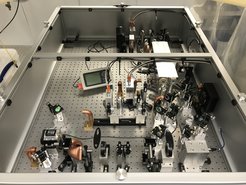Pre-stabilized laser source for ETpathfinder
We provide the pre-stabilized laser source with a wavelength of 1550 nm for ETpathfinder, the Einstein Telescope test facility currently being set up in Maastricht.

Gravitational-wave detection requires power and frequency noise levels below that of typical commercially available laser systems. That is why gravitational-wave detectors and related experiments combine commercial lasers and amplifiers with active and passive stabilization methods to achieve very low noise levels.
In addition to low-noise laser sources, future gravitational-wave observatories, such as the Einstein Telescope, need to utilize new concepts to further increase their sensitivity. For example, three of the six interferometers of the Einstein Telescope will operate at cryogenic temperatures of about 10 K to reduce the influence of thermal noise in the frequency range between 3 Hz and 30 Hz. As a consequence, other materials must be used than in current detectors. At this low temperature, fused silica, a frequently used mirror material, suffers from high mechanical loss and is not suitable. Silicon has promising mechanical properties but is not transparent at the currently used wavelength of 1064 nm. A proposed solution is the use of longer-wavelength laser light together with silicon mirrors.
To test and prototype new concepts such as longer-wavelength lasers and new materials for optical components, a test facility is currently being set up in Maastricht: the ETpathfinder. We will provide the pre-stabilized laser source for the Etpathfinder at the proposed wavelength of 1550 nm.
In our design, the beam of a low-noise, low-power external cavity diode laser is amplified in two stages to 10 W output power. To stabilize the beam pointing and reduce its higher-order mode content, the beam is filtered by an optical cavity. Active, nested, and high-bandwidth power and frequency stabilization control loops are implemented to achieve the desired laser stability.
